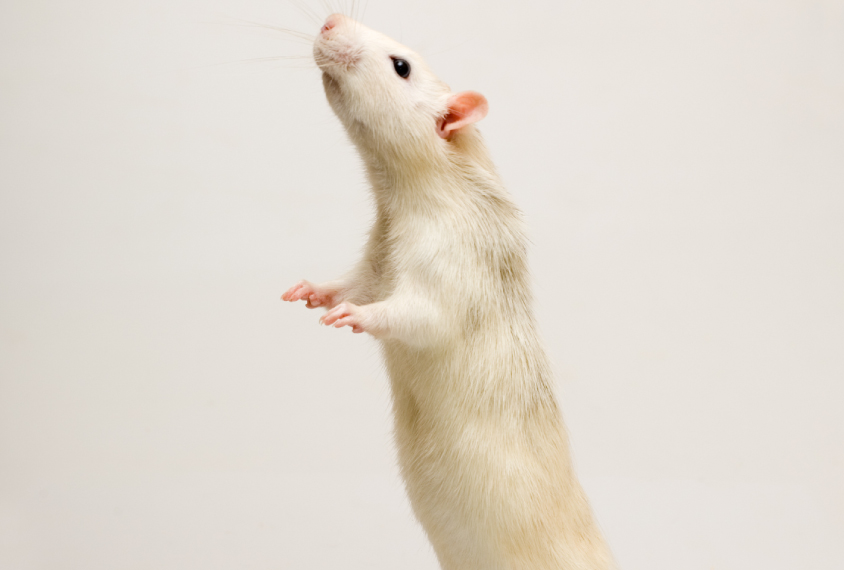
Dmitry Maslov / Getty Images
THIS ARTICLE IS MORE THAN FIVE YEARS OLD
This article is more than five years old. Autism research — and science in general — is constantly evolving, so older articles may contain information or theories that have been reevaluated since their original publication date.
Editor’s Note
This article was originally published 15 May 2014, based on preliminary data presented at the 2014 International Meeting for Autism Research in Atlanta, Georgia. We have updated the article following publication of the study 31 January in eLIFE1. Updates appear below in brackets.
Researchers have engineered two new rats with mutations in a family of genes that function at neuronal junctions, or synapses, they reported today at the 2014 International Meeting for Autism Research in Atlanta.
The rat models have a mutation in either one or both copies of SHANK2 or SHANK3. Rats are generally considered to be better than mice for modeling neurological disorders such as autism because they show complex play and other social behaviors. They also have larger brains than mice do, permitting a more finely tuned investigation of their neural pathways.
“We built a SHANK3-deficient rat model to understand the neural basis of autism,” says Hala Harony-Nicolas, an instructor in psychiatry at the Icahn School of Medicine at Mount Sinai in New York, who presented the SHANK3 work.
The rats with SHANK3 mutations have trouble remembering their peers and focusing on a task. Those with SHANK2 mutations show persistent repetitive behaviors and tend not to interact with other rats. Treatment with oxytocin, a neurotransmitter famous for enhancing some social skills, fixes many of the deficits seen in the SHANK3 rats. The researchers did not test the effect of oxytocin on the SHANK2 rats.
“The oxytocin results are really intriguing,” says Jacqueline Crawley, professor of psychiatry at the University of California, Davis, who was not involved in the study.
Drop anchors:
SHANK2 and SHANK3 sit at the receiving ends of synapses and mediate neuronal signaling. Researchers have identified multiple mutations in these genes in people with autism, making them — and SHANK3 in particular — strong candidate genes for the disorder.
The SHANK3 rats lack the region of the protein that anchors it to the synapse. They show problems with attention: They are less accurate than controls when choosing between five touch screens that release a treat when lit, for example. They also tend to forget, after about one day, a rat that they’ve already met. But the rats [have intact short-term social memory,] prefer the company of another rat to an object and play normally when young.
The researchers also placed electrodes into the rats’ brains to measure signals between two distant brain regions, the hippocampus and the medial prefrontal cortex. The rats’ brains show defects in the way they regulate the strength of the signals, the researchers found.
They also express several proteins at different levels than in controls. In particular, genes are expressed differently in the hippocampus and medial prefrontal cortex, which regulate cognitive function and memory, and in the striatum — a brain region that helps regulate and coordinate movement. The affected genes in the hippocampus and cortex are involved in fetal development, whereas those in the striatum tend to be expressed during early childhood.
“SHANK3 may pose its effect in different brain regions during different developmental periods, and may be affecting different mechanisms,” says Harony-Nicolas.
[The researchers injected oxytocin into the brain cavities of SHANK3 rats and saw improvements in long-term memory and performance on the touchscreen task 10 minutes later. The drug also normalized neuronal signaling in the animals.]
In contrast to rats with mutant SHANK3, those with mutations in both copies of SHANK2 play less than controls do when young and are less likely to interact with other rats as adults. Meera Modi, a neuroscience postdoctoral fellow at Pfizer in Cambridge, Massachusetts, presented the results.
The most significant features of the SHANK2 rats, however, are movements that resemble the repetitive behaviors seen in autism. The rats tend to repeatedly rear up in their cages and almost all of them circle incessantly.
To investigate the motivation driving these behaviors, the researchers tested how often the rats would press a lever for a treat. Once taught that pressing this lever leads to a reward, most rats press it multiple times, but give up eventually. The SHANK2 mutant rats press the lever about 100 times more for the same treat than controls do. Blocking the chemical messenger dopamine in the SHANK2 mutant rats stops this behavior.
The next step is to read the rats’ brain activity using electroencephalography during this test, Modi says. That would reveal whether behavioral training or drugs normalize the activity.
For more reports from the 2014 International Meeting for Autism Research, please click here.
By joining the discussion, you agree to our privacy policy.